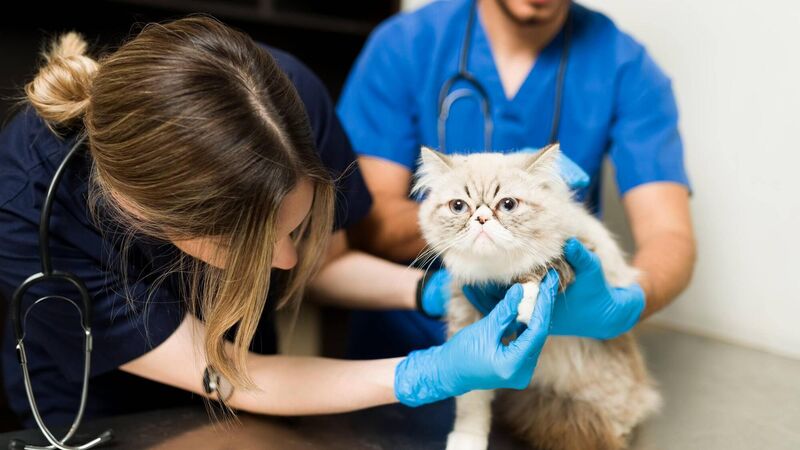Pete the Vet: How can you detect lameness in pets?

There’s a long list of causes of cat lameness, from broken toes and bites to more rare diseases like bone cancer.
We all have a natural ability to identify a lame animal, easily spotting when a pet is not moving with a steady, even gait. But most people struggle to go further than this: why is their pet limping, and what should they do about it?
Pain is the most common reason, but there are three other common causes: instability (e.g. torn ligaments or broken bones), stiffness (e.g. a long-term arthritic joint) and nerve damage (e.g. leading to muscle weakness). Each needs a different treatment approach.
Vets are trained to carry out a detailed lameness examination, and that’s the first step to diagnosing the cause. This doesn’t mean that owners need to rush to the vet immediately with every lame pet: a mild lameness due to a sprained joint may naturally resolve after two or three days. But if a pet continues to limp, veterinary intervention is essential.
Vets use a scale of one to five out of five to classify the severity of lameness. One-out-of-five would mean that the pet has a very mild limp that may be hard to detect, whereas five-out-of-five describes an animal that is not weight-bearing at all, holding the leg in the air while they hobble on their remaining three legs.
The first stage of a lameness investigation is to ask the owner for a detailed history of the problem. When did it start? What were the circumstances? Is it worse after rest or after exercise?

Next, the vet will watch the animal walking and trotting to fully evaluate the lameness. Vets sometimes take a video of the animal moving, and this can be viewed in slow motion, to observe details such as foot placement positions and limb angulations. With mild lameness, it can be surprisingly difficult to identify which limb is the focus of the problem. A healthy pet holds its head steady while they walk and run, while a lame animal’s head nods up and down.
A key tip is that when the affected leg hits the ground, the head nods up. When the good leg is placed on the ground, the head nods down. Sometimes a slow-motion video is needed to clearly see this, and if an animal has a problem on two legs at the same time, it can be very challenging to work out what’s going on.
A detailed physical examination is next. Every part of the affected leg is squeezed and tweaked. A pet cannot explain if they feel discomfort, so vets need to observe them carefully during this examination to see if any particular area is painful. Sometimes the signs can be subtle: a dog may do no more than lick its lips when the sore joint is flexed. Comparisons with the healthy leg, tweaking the same joint and watching the response can be helpful, as some pets wince when even healthy joints are manipulated. This examination does not only assess pain and stiffness: the stability of each joint is also checked, and ruptured ligaments are often identified in this way. And the nerve supply to areas of the limb is also routinely reviewed as part of the process, by noting an animal’s sensation and their ability to place their foot normally on the ground.
Once the focus of the problem has been identified, many lame pets need some type of diagnostic imaging to make a specific diagnosis: all vets have access to x-rays, while more advanced techniques such as CT or MRI scans are sometimes needed. Arthroscopy, using a fibre-optic scope to inspect the inside of an affected joint, is another new method of investigation and treatment.
Once the process has been completed, an accurate diagnosis of the cause of the lameness will be made, and optimal treatment can be given.
In real life, often for cost reasons, this full workup may not be done in such detail: if a ten-year-old labrador has creaky painful hips and is lame after rest, a physical examination will usually be enough to confirm that they have arthritic hips. Treatment can be given with this presumptive diagnosis, and that’s usually enough to solve the issue.
So what are the common reasons for lameness in dogs and cats?
Cats are simplest: many cases are caused by cat bite injuries. Cats are territorial creatures, and fights are common, with claws and teeth used as weapons. If a cat is bitten on a limb, this is painful and often becomes infected. Antibiotics and pain relief are often needed to help an affected cat recover from these injuries. Arthritis in older cats is also common. There’s a long list of less common causes of cat lamenesses, from broken toes to bone cancer: the good news is that rare conditions only happen rarely so most people don’t need to worry about these.
Lame dogs are more complex, with a longer list of causes. Arthritis is the most common issue, mostly affecting the large joints: hips, shoulders, knees and elbows. The simplest treatment is weight reduction and rest (obese dogs place more pressure on the joints, making things far worse), but most arthritic dogs need regular pain relief. This is traditionally given via daily oral prescription-only medication: many elderly dogs’ lives have been transformed by this. The recent innovation of a novel monoclonal antibody injection, given once a month, can also have an almost miraculous effect of neutralising discomfort.
Other common conditions, such as ruptured cruciate ligaments and slipping kneecaps causing severe hindlimb lameness, need corrective surgery. And rare issues, such as bone cancers, need individualised treatments.
As with many pet problems, the best treatment depends entirely on the specific diagnosis. That's why vets are here to help.






